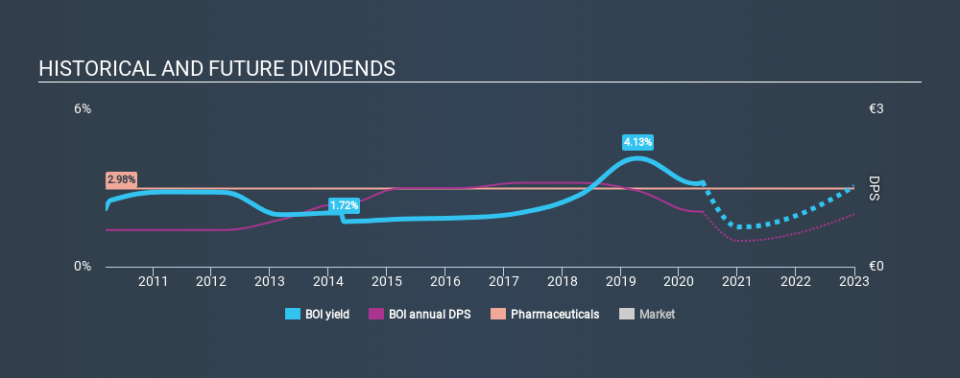It Might Not Be A Great Idea To Buy Boiron SA (EPA:BOI) For Its Next Dividend

Boiron SA (EPA:BOI) is about to trade ex-dividend in the next 3 days. Ex-dividend means that investors that purchase the stock on or after the 2nd of June will not receive this dividend, which will be paid on the 5th of June.
Boiron's next dividend payment will be €1.05 per share, and in the last 12 months, the company paid a total of €1.05 per share. Calculating the last year's worth of payments shows that Boiron has a trailing yield of 3.2% on the current share price of €32.6. Dividends are a major contributor to investment returns for long term holders, but only if the dividend continues to be paid. We need to see whether the dividend is covered by earnings and if it's growing.
Check out our latest analysis for Boiron
Dividends are typically paid out of company income, so if a company pays out more than it earned, its dividend is usually at a higher risk of being cut. Fortunately Boiron's payout ratio is modest, at just 45% of profit. A useful secondary check can be to evaluate whether Boiron generated enough free cash flow to afford its dividend. Boiron paid out more free cash flow than it generated - 190%, to be precise - last year, which we think is concerningly high. It's hard to consistently pay out more cash than you generate without either borrowing or using company cash, so we'd wonder how the company justifies this payout level.
Boiron does have a large net cash position on the balance sheet, which could fund large dividends for a time, if the company so chose. Still, smart investors know that it is better to assess dividends relative to the cash and profit generated by the business. Paying dividends out of cash on the balance sheet is not long-term sustainable.
While Boiron's dividends were covered by the company's reported profits, cash is somewhat more important, so it's not great to see that the company didn't generate enough cash to pay its dividend. Were this to happen repeatedly, this would be a risk to Boiron's ability to maintain its dividend.
Click here to see the company's payout ratio, plus analyst estimates of its future dividends.
Have Earnings And Dividends Been Growing?
Companies with falling earnings are riskier for dividend shareholders. If earnings fall far enough, the company could be forced to cut its dividend. Readers will understand then, why we're concerned to see Boiron's earnings per share have dropped 13% a year over the past five years. Ultimately, when earnings per share decline, the size of the pie from which dividends can be paid, shrinks.
The main way most investors will assess a company's dividend prospects is by checking the historical rate of dividend growth. Boiron has delivered an average of 4.1% per year annual increase in its dividend, based on the past ten years of dividend payments.
The Bottom Line
Has Boiron got what it takes to maintain its dividend payments? Boiron's earnings per share have fallen noticeably and, although it paid out less than half its profit as dividends last year, it paid out a disconcertingly high percentage of its cashflow, which is not a great combination. Overall it doesn't look like the most suitable dividend stock for a long-term buy and hold investor.
With that in mind though, if the poor dividend characteristics of Boiron don't faze you, it's worth being mindful of the risks involved with this business. In terms of investment risks, we've identified 1 warning sign with Boiron and understanding them should be part of your investment process.
If you're in the market for dividend stocks, we recommend checking our list of top dividend stocks with a greater than 2% yield and an upcoming dividend.
Love or hate this article? Concerned about the content? Get in touch with us directly. Alternatively, email editorial-team@simplywallst.com.
This article by Simply Wall St is general in nature. It does not constitute a recommendation to buy or sell any stock, and does not take account of your objectives, or your financial situation. We aim to bring you long-term focused analysis driven by fundamental data. Note that our analysis may not factor in the latest price-sensitive company announcements or qualitative material. Simply Wall St has no position in any stocks mentioned. Thank you for reading.

 Yahoo Finance
Yahoo Finance 
